It happens to the best of us: We rush into a group-fitness class 10 minutes late and jump in at full speed. Or we launch into a quick run over our lunch hour, not wanting to waste a moment of precious time. Whenever we’re pressed, we tend to skip the warm-up, figuring that the main workout is what really counts. But nothing could be further from the truth.
“If you’re going to scratch something in your routine, it should never be the warm-up,” says Angie Brambley, assistant varsity strength-and-conditioning coach at Princeton University. Not only is warming up essential to preventing injury, she notes, but it makes you faster, fitter and stronger over time. In other words, the warm-up is not a prologue to fitness — it’s Part 1 of the main act.
Warming up will make your workout feel easier than if you were just hopping off the couch and going for it, adds Thomas Trojian, MD, team physician for the University of Connecticut Department of Athletics and director of the Injury Prevention and Sports Outreach Programs at the New England Musculoskeletal Institute. Among offering other perks, Trojian says, a proper warm-up:
- Increases muscle core temperature, thus decreasing work required for muscle contraction and making movement feel easier.
- Allows higher maximum cardiac output and oxygen consumption. (Translation: It increases your endurance and speed.)
- Causes blood vessels to dilate, which aids the transportation of oxygen and nutrients to the working muscles (so you can run faster and jump higher).
- Increases your range of motion by heating the synovial (lubricating) fluid in your joints, improving flexibility.
- Warms you up mentally, increasing motivation and focus.
(Need more reasons? See “Gradual Is Good”.)
OK, so now you know why you should be warming up. The next thing you need to know is how to warm up properly. In the past, experts suggested you begin every warm-up with a five-minute jog or a couple of warm-up laps, followed by some static stretches. But that warm-up is incomplete on its own, explains Rachel Cosgrove, CSCS, a USAT triathlon coach based in Santa Clarita, Calif., and author of The Fit Chick Body: The Revolutionary Plan for Losing Fat, Empowering Your Mind, and Getting the Body You Want. “Sure, it gets you sweaty and warm, but jogging in one plane of motion with a limited range of movement, at each joint doesn’t prepare you for whole-body motion or flexibility — which most good workouts include,” she says.
To better prepare your body for action, Trojian says, do a dynamic warm-up — exercises that focus on technique, range of motion and speed of movement, and that replicate the movements you plan to do during your workout.
“Holding stretches [static stretching] is not helpful before a workout, and there’s evidence that it may even be harmful,” says Trojian. Dynamic movements, on the other hand, have been shown to prevent injury, increase power output and improve vertical jump. In other words, save the toe-touches and quad stretches for postworkout when your muscles are already good and warm. (For more, see “Stretch and Reach: The Unexaggerated Truth About Stretching”.)
How Warm Is Warm Enough?
There is no hard evidence prescribing precisely how much warm-up is needed before a workout or a race. Most recommendations are in the 10- to 20-minute range, though some people need less or more time. “Depending on your fitness level and the particular movements you are performing, the warm-up may feel like a workout in itself,” says Brambley. And that’s OK. At first, after a thorough warm-up, you may need to modify the main portion of your workout until your fitness and work rate (level of intensity) improve.
A rule of thumb: The higher your fitness level, the longer you probably need to warm up. (The fitter you are, the longer it takes to get your heart rate up and the more muscle mass you have to get warm.) At a bare minimum, though, for even the shortest workouts, you should allow for a five-minute warm-up.
Below, you’ll learn how to do it right. There’s no special equipment required, so you can do these anywhere, and before every workout. Complete them all for a 20-minute buildup that will prepare you for just about any sport or activity. Or, if you’re short on time, choose just a few that are well suited (see the “Best Before” suggestions) to the activity you plan to complete.
The Move: Jumping Jacks

Best Before: Any workout. This is perhaps the best all-around warm-up if you’re short on time and can complete only one move.
The Benefit: This easy, full-body movement gets your joints moving and raises your core body temperature. “Sometimes people balk at doing jumping jacks, but it’s one of the easiest ways to increase muscle elasticity and prevent muscle strain,” says Brambley.
How To: Jumping jacks were probably a staple of your grade school gym class, but here’s a refresher on proper technique: Begin by standing with your feet close together and arms at your sides. Tighten your abdominal muscles to pull your pelvis forward and straighten your lower back. Bend your knees slightly and jump, landing with your feet a little more than shoulder-width apart. At the same time, raise your arms over your head. You should be on the balls of your feet. Keep your knees slightly bent while you jump again, bringing your feet together and your arms back to your sides. Repeat the exercise for 30 seconds. Rest briefly and then repeat 30-second intervals until you break a light sweat.
The Move: Elliptical Trainer
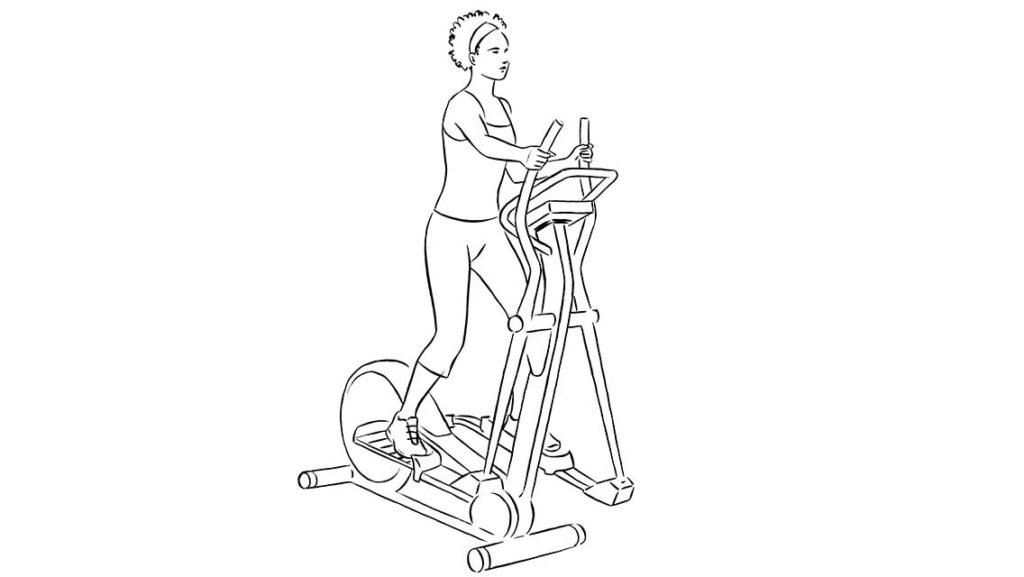
Best Before: Strength training or workouts using cardio equipment.
The Benefit: The elliptical machine provides a no-fuss, low-impact way to increase your core body temperature and lubricate your joints, and if you’re going to hit the cardio equipment anyway, an elliptical trainer is probably a convenient way to break a sweat. (Pair this activity with a few different dynamic exercises, such as walking lunges, pushups with arm rotations and body-weight squats, to incorporate a more complete range of motion.)
How To: Make sure the elliptical machine is on its easiest settings and start moving slowly, building your pace for five to 10 minutes or until you start to sweat. If you’re fit, you may want to increase the resistance level or incline after a minute or two. Once you feel warm, move on to the rest of your workout. If you’ve never used an elliptical trainer before, get some tips from a staffer to make sure you use proper form.
The Move: Walking Lunges
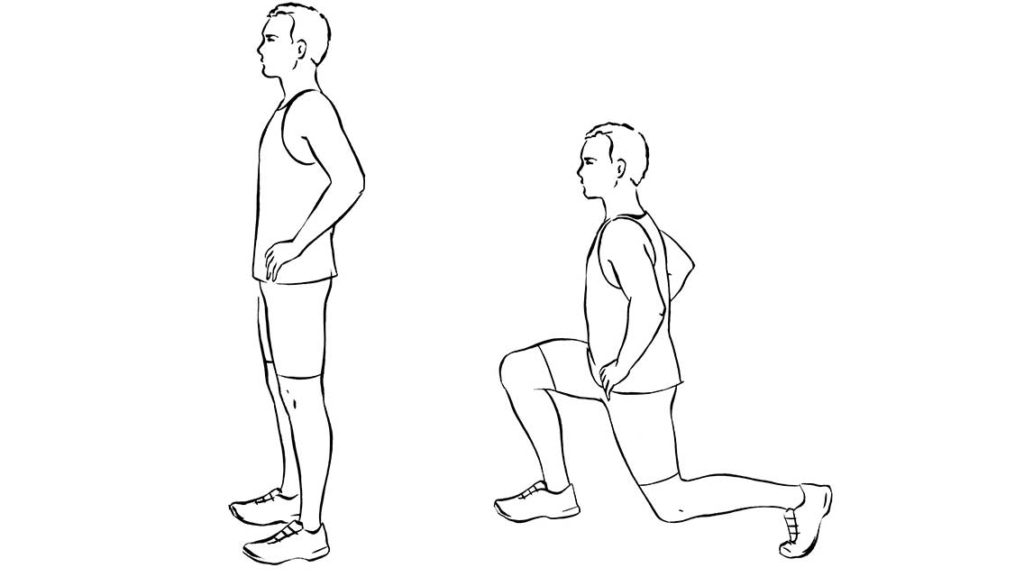
Best Before: Running, tennis, cycling, hiking, basketball (or any activity that emphasizes lower-body movement or balance) and strength training.
The Benefit: Increases range of motion in your lower body, improves balance, gets blood flowing to major muscle groups and increases core temperature. “Your glutes usually need some help getting started, along with your postural muscles,” Cosgrove notes. “Lunges do the trick.” (See “Go-To Glutes”.)
How To: Position feet shoulder-width apart, your hands on your hips. Take an exaggerated step directly forward with your right leg. Keep your right knee aligned over your ankle and toes pointing straight ahead (your knee should not jut out in front of your ankle). Keep your torso vertical. Keeping your right foot flat on floor, forcefully push off with the left leg and bring it forward to meet the lead leg. Next, repeat the move, starting with your left leg. Complete two sets of 10 lunges.
The Move: Butt Kicks

Best Before: Any activity that demands a lot of your legs and knees, such as running, jumping, climbing, skiing, cycling classes, step classes or stair-climbing machines.
The Benefit: Butt kicks are one of the best ways to warm up your leg muscles and increase your circulation and core body temperature. If you’re a runner, you may notice that butt kicks improve your running posture and stride, too.
How To: Keep your back straight and lean forward slightly so that your chest is over the toes. Jog forward with an exaggerated step, bringing the heels of your feet up to touch your hamstrings; keep your ankle dorsiflexed (it should look and feel as though you’re kicking your own butt with your heel). Keep your elbows close to your sides and think about moving your thumb from your chin to your back pocket. Place the emphasis on doing a high number of repetitions rather than going for distance. Repeat for 30 seconds, rest, and repeat again for three sets.
The Move: High Knee Pulls
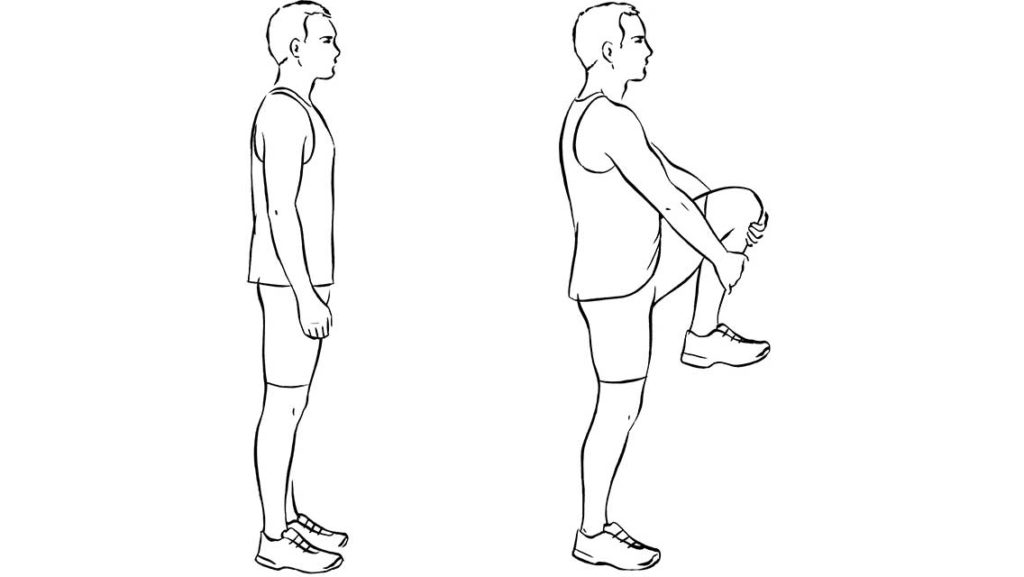
Best Before: Any workout that involves jumping (such as a plyometric routine or pick-up basketball game), field sports (such as soccer or ultimate Frisbee), running (especially sprints), or dance and aerobics classes.
The Benefit: This dynamic stretch increases flexibility in your hamstrings and hip flexors, and warms your glutes, hips, ankles and knees. It’s a great alternative to static stretching, experts note, because it gently warms and stretches muscles without overdoing it.
How To: Begin with your feet shoulder-width apart. Pull one knee up and into the chest (hug the knee with your arms for a bigger stretch). Maintain the pull for a count of five, your body erect (avoid leaning back). Keep your ankle dorsiflexed to work on running form while you do this exercise. Return your foot to the ground and repeat with the opposite leg. Complete a set of 10 reps per leg.
The Move: Body-Weight Squats

Best Before: Strength training, climbing, cycling, hiking or running.
The Benefit: A longtime favorite of experts, the squat switches on almost every major muscle group — core, glutes and calves — while raising your body temperature; increasing the range of motion in your hips, knees and ankles; and improving your overall strength.
How To: Keep heels flat on the floor, chest out and chin up. Begin the descent by flexing at the hips (pushing the hips back and down) while bending the knees. Look straight ahead and keep the chest out throughout the movement. Squat until the tops of the thighs are parallel to the floor (or slightly deeper to further engage your hamstrings). Rise from the bottom position forcefully but under control — don’t bounce. Keep heels flat on the floor throughout the entire range of motion. The shoulders must rise before the hips do so that the lifter stays in the correct position. The lower back should keep its natural curve throughout the movement, the torso angled slightly forward. Repeat for a set of 10.
The Move: Backward Step-Over
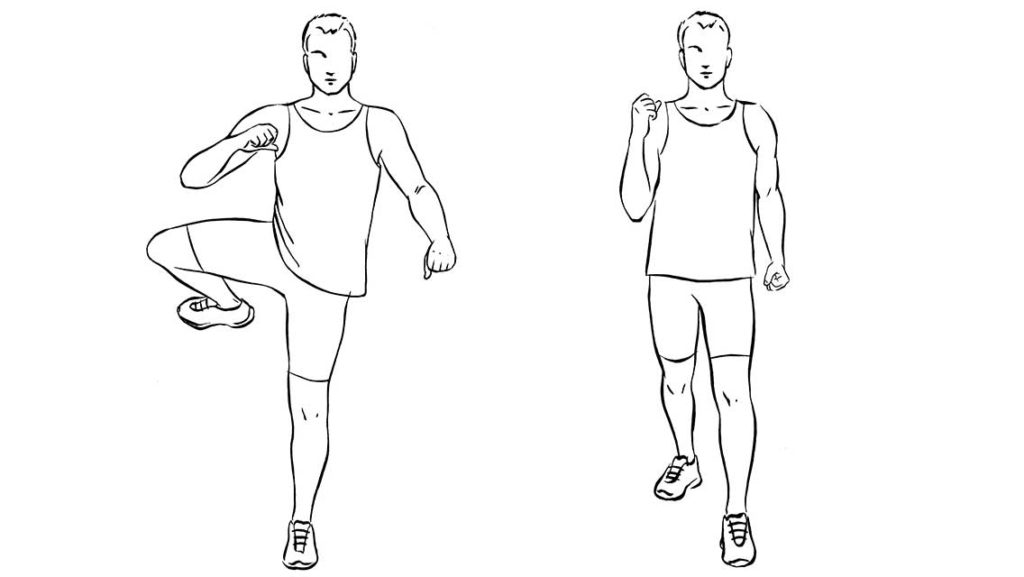
Best Before: Any workout or activity that requires balance and reach, such as tennis, core workouts, trail running, dance or basketball.
The Benefit: Increases body temperature and circulation, improves flexibility and active range of motion in the hips, and boosts strength in the muscles around the hip. This move can also improve your dynamic balance, Trojian notes, making you quicker on your feet and less likely to fall.
How To: Stand on a flat, even surface (such as a tennis court or ball field) with feet shoulder-width apart. Lift one knee up, and rotating outward at the hip, step backward as if you’re trying to clear a hurdle behind you, and place the foot down so it’s facing forward. Repeat with the other leg and work your way across the court or field, doing approximately 10 reps per leg, then turn around and repeat.
The Move: Trunk Rotations
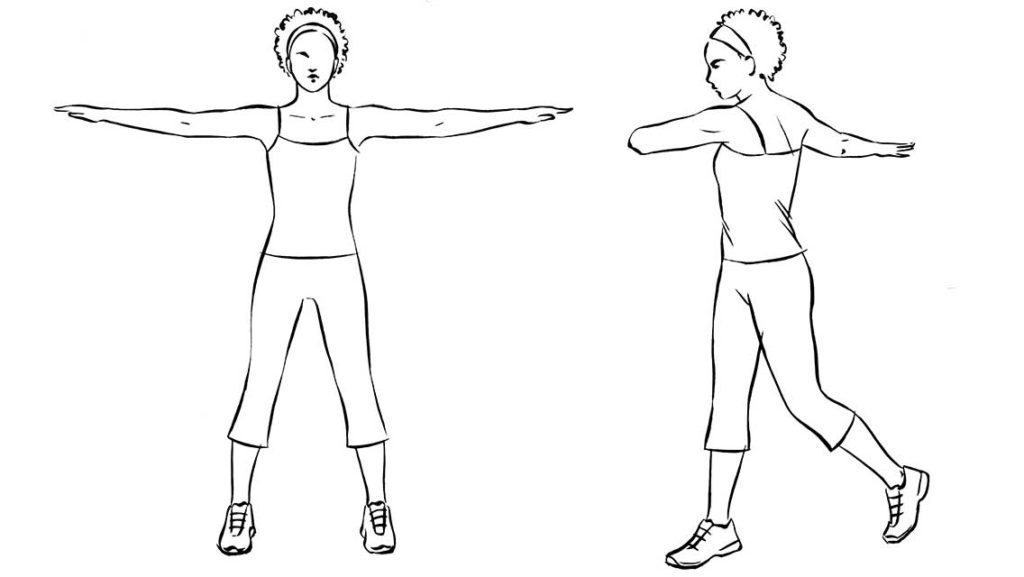
Best Before: Strength training, yoga or Pilates, dance classes, swimming, tennis, and ball sports such as softball or basketball.
The Benefit: Improves strength and flexibility in the legs, core and shoulders while increasing blood flow and body temperature.
How To: Standing in one spot, spread the feet apart and establish a sturdy base of support. Bring the arms up to shoulder height and gently rotate the torso to one side and then the other. Gradually lower the body by bending the knees and pivoting on the balls of the feet as you rotate from side to side. Perform two sets of about 15 to 20 twists in each direction.
The Move: Pushups With Arm Rotations
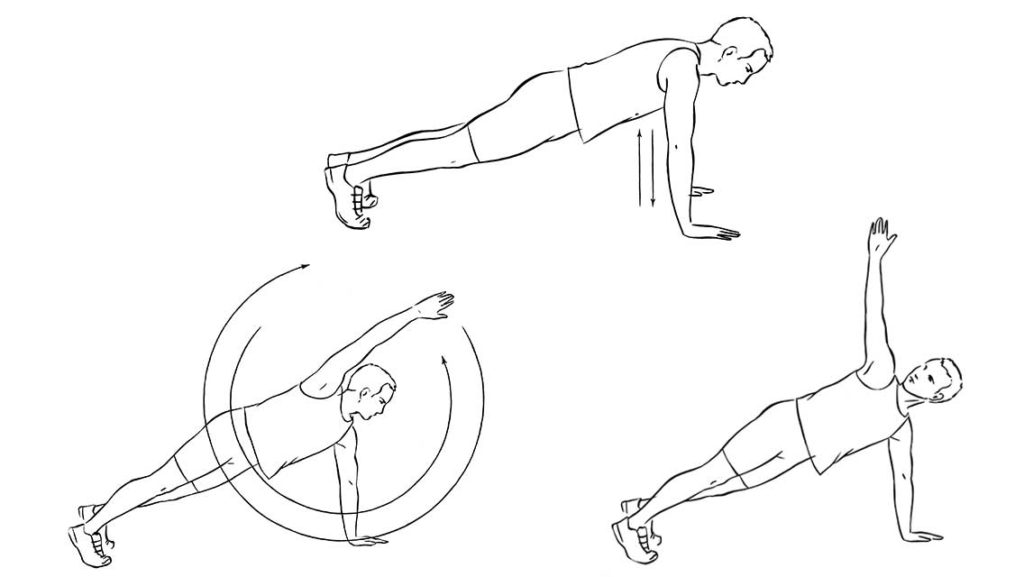
Best Before: Strength training, swimming, yoga or Pilates, tennis, or any activity that places demands on the upper body.
The Benefit: Even if you’re a runner or cyclist, you need to warm up your upper body. This move increases range of motion in your shoulders and arms, fires up your core, and improves your upper-body and abdominal strength.
How To: Get into the classic pushup position, hands and feet shoulder-width apart. Perform a pushup, lowering your chest toward the floor and pushing back up. Upon reaching the top of the pushup, lift one hand toward the sky and rotate the body 45 degrees. Perform one arm circle forward and then one arm circle backward before returning to the top position of the pushup. Perform another pushup, rotate to the other side, and repeat arm circles. Repeat for a set of five. (Note: If this move is too challenging, do a set of regular pushups followed by arm circles in a standing position.)
With your body warm and your heart pumping, you should feel ready to take on the rest of your workout. But even if you cut your workout short, your body will still enjoy gains in performance and muscle recruitment that you might otherwise miss. “Most people rarely use their entire bodies in a workout,” Brambley explains. “This comprehensive warm-up routine ensures that you don’t miss a thing.”
Warm-Up Dos and Don’ts
Wondering if you’re on the right track? Keep these simple guidelines in mind as you complete your warm-up routine.
- DO start slowly, allowing your body to loosen up and your heart rate to rise gradually. By the end of your warm-up, however, you should be up-to-speed.
- DON’T limit range of motion during your warm-up. Most workouts require full-body motion and flexibility, so it doesn’t make sense to just shuffle through your warm-up.
- DO be sure to recruit the muscles you plan to use during your workout. If you’re warming up before a run, make sure to include upper-body exercises in addition to lower-body moves. Planning to lift weights? Do pushups with arm rotations and consider using a resistance band to mimic some of the moves, such as bench presses, rows and squats.
- DON’T forget the dynamic exercises. Research suggests that static stretching before exercise doesn’t help performance and may actually hinder it, since cold muscles are more prone to tearing. Save static stretches for after your workout, and make your warm-up more dynamic instead.
Jumpstart Your Motivation
The bad news: If your head’s not ready to work out, your body won’t be either. The good news: The warm-up is a great way to mentally prepare for exercise. It hones your focus, builds confidence and gets the feel-good endorphins flowing, notes Chris Eschbach, PhD, an exercise physiologist and director of the Human Performance Laboratory at Meredith College in Raleigh, N.C. “From a psychological standpoint, it gets your head in the game.” Here are a few tips for getting motivated to move.
- Tell yourself that you only have to do the warm-up and can skip the workout if you still don’t feel like exercising. Usually, by the time the warm-up is complete, you’ll be ready to keep going. If not? Don’t worry, since your body benefits from the warm-up alone.
- Use your warm-up time as an opportunity to visualize your workout and set some goals for the day or week.
- Let go of stress. As you begin to move your body, imagine that you’re shaking off the stress of the day. Tension hides in tight muscles and joints, and warming up is a great release.
- Keep water or a sports drink close by during your warm-up. It will help you stay hydrated throughout your workout, and a sip of cool water can be invigorating when you need a boost.
This article has been updated. It was originally published online on October 1, 2009.


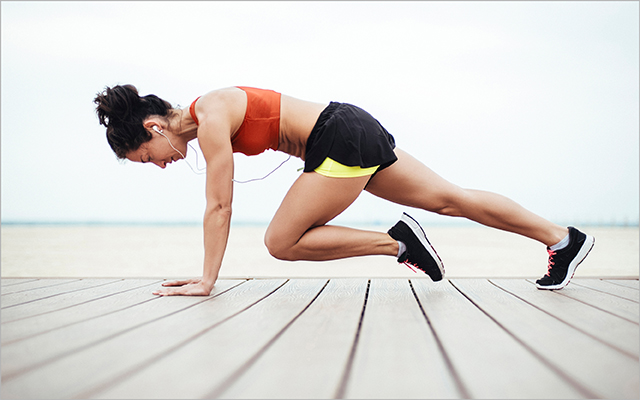
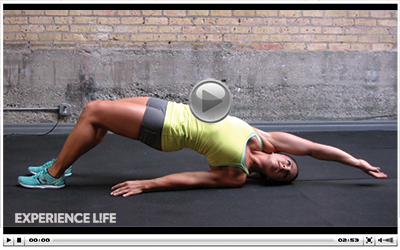
This Post Has One Comment
Thank you
I plan to incorporate at least 5 of these workouts daily to restart playing pickleball